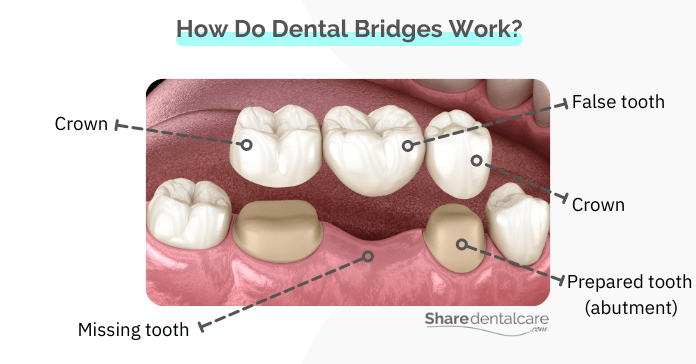Losing a tooth/teeth can affect your ability to chew, your smile, and overall health, but there are many options for replacing missing teeth. One of these options is the dental bridge, which is a good solution for replacing one, two, or more missing teeth. Dental bridges are aesthetic restorations and are considered one of the most durable types of dental restorations. However, they have some drawbacks. In this article, we will go over how a dental bridge works, can you get a bridge for two missing teeth, and what are the benefits and drawbacks.
What are Dental Bridges & How Do They Work?
A dental bridge is a restorative treatment option for one, two, or more missing teeth. It consists of two or more crowns connected to a fake tooth/teeth in between. The false tooth is known as pontic. The crowns are permanently cemented to the adjacent teeth, which are known as abutment teeth. A fake tooth bridge requires the preparation of abutment teeth, which involve shaping the natural teeth to accept crowns.
If you have one, two, or more missing teeth, the pontics (false teeth) fill the gap, and the crowns in the dental bridge are cemented onto the abutment teeth on either side of the gap. Dental bridges can be used for cosmetic and functional purposes.

Can You Get a Bridge for Two or More Missing Teeth?
Yes, you can replace two or more teeth with a dental bridge. However, The higher the number of missing teeth, the more crowns (abutment teeth) needed to support the bridge. For example, If you have two missing teeth, you may need two or more abutment teeth (crowns) for supporting the bridge, depending on:
- The location of the missing teeth.
- The size of the gap.
- The condition of the neighboring teeth.
- What kinds of forces are applied on the bridge while in use.
- The presence of parafunctional habits (e.g., clenching/grinding, etc.).
If the missing teeth are in crowded areas, it may be more challenging for your dentist to find adequate space for the abutment teeth. Therefore, two or more crowns may be needed for support.
Benefits of a Dental Bridge for Two Missing Teeth
Dental bridges are one of the most durable, fixed, and long-lasting dental restorations, which last for up to 15 years. However, their lifespan and effectiveness largely depend on the oral health of the patient. Dental bridges help restore missing teeth, improve chewing function, make talking easier, and enhance your smile. Dental bridges are also less expensive than dental implants, which is another option for replacing two missing teeth.
If you have missing teeth in your mouth, a dental bridge can bring back balance to your bite and provide a more aesthetically pleasing smile.
Drawbacks of a Dental Bridges
While dental bridges are a good solution if you’re missing two teeth, they have some drawbacks as well:
- They may require more than two crowns (abutment teeth) on either side of the gap for support, which means more tooth preparation, more time in the dental chair, higher costs, and more discomfort.
- Dental bridges are not suitable for people who don’t have teeth on any side of the gap.
- If the abutment teeth are compromised in any way (e.g., they are broken, cracked, decayed), a dental bridge won’t be an ideal treatment option, or you may need more abutment teeth.
- Dental bridges can’t be used for teeth that are far from each other. Read more about “dental bridge broke in half“.

Implants for Replacing Missing Two Teeth
Dental implants are a good alternative to a bridge for two missing teeth. If you have two missing teeth, you will need two implants to support two crowns. Implants are artificial roots placed into your jawbone, and they’re designed to fuse with the bone over time. Dental implants are considered permanent restorations. They look and feel like natural teeth, improve chewing ability, preserve the jawbone tissue, and help promote bone growth around them. Also, they don’t require the preparation of adjacent teeth. The success rate of dental implants is over 95%.
However, dental implants are more expensive than bridge treatments. Also, the placement of implants requires surgery, which can cause post-operative pain and swelling. The healing process can take from 2 to 4 months.
Partial dentures are an affordable option and can replace one or more missing teeth. However, they are not as stable, strong, and durable as bridges and implants. Read more about single molar dentures.
Bridge for Missing Two Teeth – Conclusion
A dental bridge is a good option for replacing two missing teeth. It is strong, durable, and long-lasting. A dental bridge can restore your smile and improve chewing function. However, there may be some drawbacks that you should know before choosing it as a treatment option. On the other hand, dental implants are a good alternative to a bridge for replacing two missing teeth. Talk to your dentist to learn more about dental bridges and if they’re the right treatment for you.